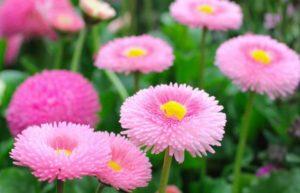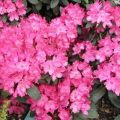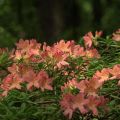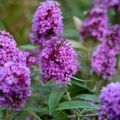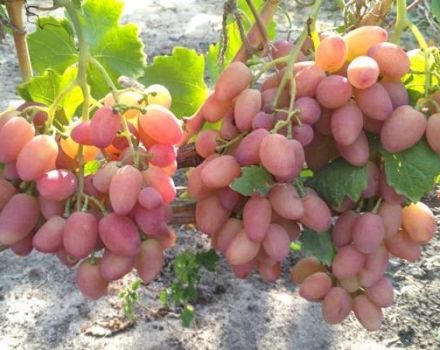Rules for growing and caring for rhododendron at home
Rhododendron, or azalea, can be easily grown at home. Indoor exotic plant thrives in a room with cool air. Azalea needs regular watering, feeding and loves acidic soil. If the room is too hot and dry, it quickly sheds foliage. With proper care, azalea stays consistently green and blooms every year.
Kinds
Rhododendron is a flowering plant from the Heather family. The name translated from Latin means - rosewood. Indoor azaleas also belong to rhododendrons. Although in fact Azalea is one of the varieties of rhododendrons. The flowers of this plant from a distance resemble large roses.
There are about 600 species of rhododendrons. It is an evergreen or deciduous (semi-deciduous) shrub or tree. The plant can be tall, low, with erect stems or ampelous shoots.
This plant has large, bright flowers, collected in lush inflorescences of 3-20 pieces each. The petals are colored lilac, orange, red, pinkish, white. The rhododendron growing in the garden blooms in spring and blooms for 2-4 weeks. During flowering, the plant emits a delicate aroma, although the tree itself is poisonous. Differs in longevity, can grow up to 50 years.
Big
Evergreen trees. Can grow up to 10 meters in height. Leaves are thin, oblong, dark green, shiny. The length of the leaf is 30 centimeters. Flowers - large, pink or snow-white, in the form of bells, collected in inflorescences of 12-29 pieces.
Griffitz
Evergreen shrub with straight branches, growing up to 1.4-3.5 meters. It has oblong, dull green above and yellow-green below, bare leaves (up to 30 centimeters long).White or slightly pinkish flowers are collected in huge loose inflorescences (each has 3-9 flowers). The plant perfectly tolerates the cool winters of the southern latitudes.
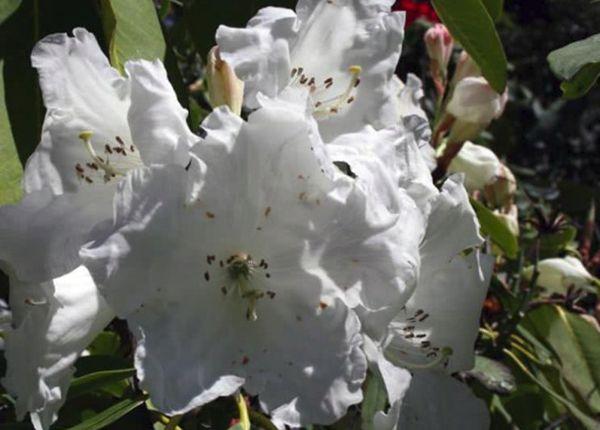
Hooker
The plant is named after the English botanist Hooker, who first described rhododendrons in detail. It is an evergreen shrub (up to 2.9 meters in height), with oblong leaves and large poisonous pink flowers. Flowers are bell-shaped, they are collected in inflorescences of 4-6 pieces each.
Decorative
Tall, evergreen shrub. It has oblong, dark green, smooth leaves up to 22 centimeters long. Loose and lush inflorescences consist of 8-10 flowers of snow-white or pinkish color. Flowering - from spring to mid-summer.
Pointed
Huge shrubs growing up to 2.9 meters in height. Young stems are pubescent. This plant has small (up to 6 centimeters) greenish leaves with a sharp tip. The flowers are large, snow-white, with five petals.
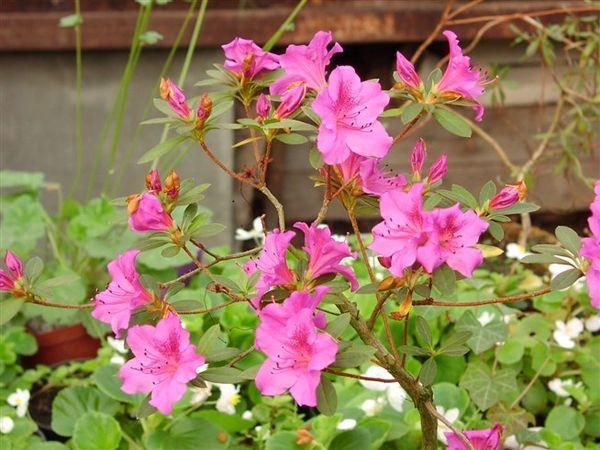
Indian
Lush shrub that grows up to 2 meters high. Leaves are oblong, shiny, green. They reach a length of 4 centimeters. The flowers are huge, like lilies. The color of the petals is pale lilac or pastel red.
Katevbeysky
This rhododendron is also called Katevbinsky. This is an evergreen, voluminous-looking shrub. The crown is wide, reminiscent of a huge ellipse. Blooms for almost a month (May-June). Flowers - pale lilac or red-violet, collected in inflorescences of 14-20 pieces each. Winter-hardy and shade-tolerant plant.
Beautiful
Evergreen three-meter shrub. Leaves are medium-sized, green, shiny, oblong, with a pointed tip. The flowers are collected in lush inflorescences, pale pink or white, with specks on one of the petals. They look like orchids.
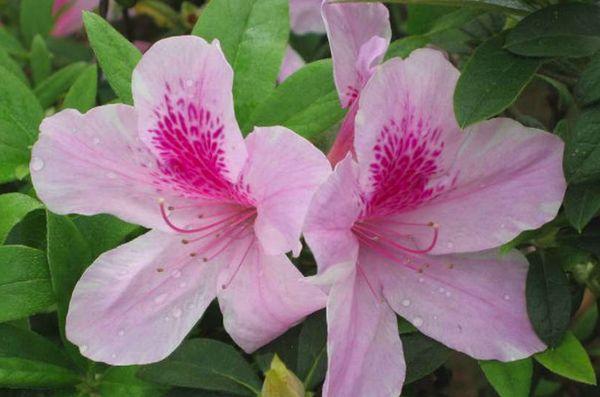
Marigold
Tall shrub that sheds foliage. It blooms in early summer. Leaves are small (8 centimeters in length), greenish, oblong, similar to cherry. The flowers are coral or orange in color, with wavy edges, collected in inflorescences.
Pontic
Evergreen three-meter shrub. Leaves - elongated, with a sharp tip, dark green, smooth. Flowers are collected in lush spherical inflorescences. They can be lilac or pale pink. Delivers a pleasant aroma.
Simsa
Tall shrubs that do not shed their foliage. Leaves are smooth, shiny, greenish, oblong, with a pointed tip. The flowers are large, lily-like. Petals can be coral, pinkish, lilac, red. Flowers are simple, as well as double.

Stupid
One meter or two meter bushes with evergreen foliage. The plant has green, oblong, pointed upward leaves. Flowers are collected in lush inflorescences. The petals can be pale purple or deep pink.
Japanese
Deciduous shrub. Crohn's - strongly branched, wide. In length, the shrub can stretch up to 2 meters. The leaves are oblong, thin, green in summer, and burn with orange-purple colors in autumn. Flowers - bell-shaped, large (with a diameter of 8 centimeters), orange-red, collected in inflorescences of 6-12 pieces. Flowers appear with the opening of the first leaves. The shrub blooms for about one month. From a distance, the flowering bush resembles a blazing fire.
Home cultivars
Dwarf, compact shrubs, 15-40 centimeters high, are grown in the apartment. There are standard azaleas on sale. They have a long, straight leg and a lush, green crown covered with bright flowers. They buy indoor dwarf rhododendrons during the flowering period (from December to April). Azaleas are given for Christmas, birthday or Easter.
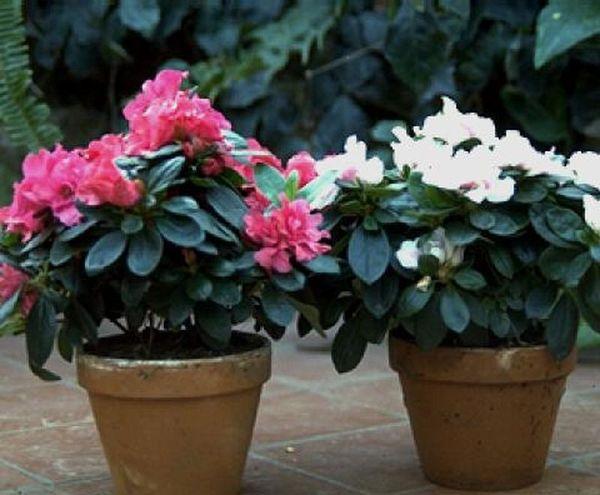
Snowflake
Azalea with delicate snow-white (pink in the middle) large flowers, collected in lush inflorescences. Bush - low, with a spreading crown. Leaves are small, oblong.
Albert elizabeth
A plant with large double flowers.Flowers are pale pink or snow-white, with a bright border around the edges of the petals. They look like carnations. Flowering is abundant, from December to April.
Celestine
A late blooming azalea with lush coral-colored flowers and small oblong leaves. The bush is abundantly covered with flowers from above, because of which the leaves are almost invisible.
Starfish
Compact bush with small dark green leaves. The flowers are white, with crimson dots on one of the petals.
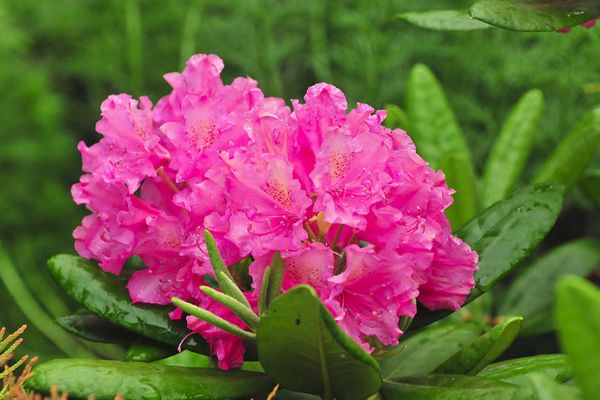
Melina
A dwarf undersized shrub. The flowers are crimson in color, gathered in lush inflorescences.
Madame Joly
A short, compact bush with flowers resembling lilies, collected in inflorescences. The color of the flowers is pale pink.
Czardas
The bush blooms in April. Has a cream shade, terry, fragrant flowers.
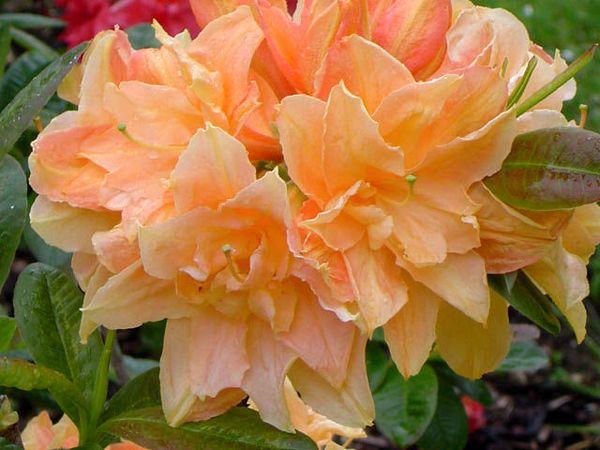
Satan
Tall, spreading shrub. Blooms profusely. The flowers are fiery red, with wavy edges of the petals.
Slavka
Low bush with a lush crown. Flowers are snow-white, collected in inflorescences.
Golden lights
Bush of medium height. Blooms profusely with golden yellow flowers.
Azure
Strongly branched and undersized bush. Flowers - purple, collected in lush inflorescences.
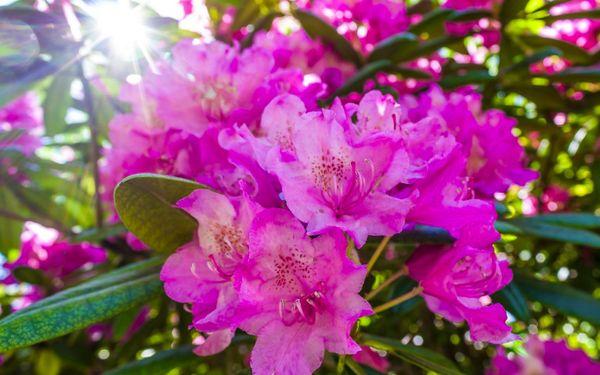
Koichiro Wada
Low, abundantly flowering bush. The flowers are snow-white, with crimson dots on one of the petals. They look like orchids.
Features of growing in an apartment
Small dwarf bushes are kept in the house. This is a luxurious plant, delighting with lush fresh flowers in the winter cold season or in early spring. Azalea flowers come in various shades, simple and double, fringed and corrugated.
In the eastern states, a bonsai is formed from a small flowering bush. Azalea is often given as a gift at the time of flowering. When buying, pay attention to unblown buds.
Once in a warm apartment, very soon this plant crumbles. Indoor conditions are not suitable for azaleas. After all, they prefer a low temperature (8-11 degrees Celsius) and high humidity from November to March. In a dry and hot room, azaleas die quickly. True, in greenhouses or in conditions suitable for them, they can live a long time, and bloom for the next season.

The plant blooms from December to April. Prefers bright but diffused light. In summer and spring, the air temperature should be 15-18 degrees. In the autumn-winter period of rest, the temperature is lowered, and watering is reduced. Azalea is watered regularly. Make sure that the ground is constantly wet.
During flowering, the azalea needs abundant watering. It is advisable to spray the plant once a day; in the heat, this procedure is carried out three times. It is not difficult to grow and care for azaleas. The main thing is to ensure a normal temperature regime and regular watering.
Place of landing in the apartment
Azalea looks great in a single exposure. In the apartment, it can be placed next to other indoor ornamental plants. Azalea prefers not too high temperature and high humidity. In no case should the azalea pot be placed on the windowsill, near the battery.
Lighting
It is advisable to place the pot with azalea away from direct sunlight. The plant grows well in partial shade. Azalea requires diffused bright light.

Temperature
From late autumn to early spring, it is advisable for the plant to provide a temperature equal to 9-11 degrees of heat. In summer, the azalea can be taken out into the garden or on the terrace. True, the rhododendron must constantly be in partial shade.
Humidity
This is a moisture-loving plant. The soil in the pot must be constantly moist. Azalea is regularly watered and the leaves are watered.
How to choose soil
For rhododendrons, it is best to buy a ready-made substrate: for azaleas or heather.
The soil mixture must be slightly acidic, it must contain coniferous soil, peat, sand, nutritional supplements.
- Option one.It is better for novice gardeners to buy ready-made soil mixture. Soil for azaleas should contain peat, sand, drainage, mineral additives, vermicompost, coniferous and leafy soil.
- Option two. If you wish, you can prepare the soil mixture yourself. It should contain in equal proportions heather, leafy soil, sand, high moor peat, crushed pine bark. The soil is fertilized with mineral and organic additives. Usually, 5 grams of top dressing is taken for one liter of water.
- Option three. In equal proportions, take coniferous, leafy soil, sand, peat. For loosening, add coconut flakes or crushed coniferous sawdust. The land for azaleas must be disinfected and ignited at high temperatures.
Care
Azalea is a demanding plant. He needs to be looked after regularly. Azalea loves fresh air. It is advisable to ventilate the room in which it is located constantly.
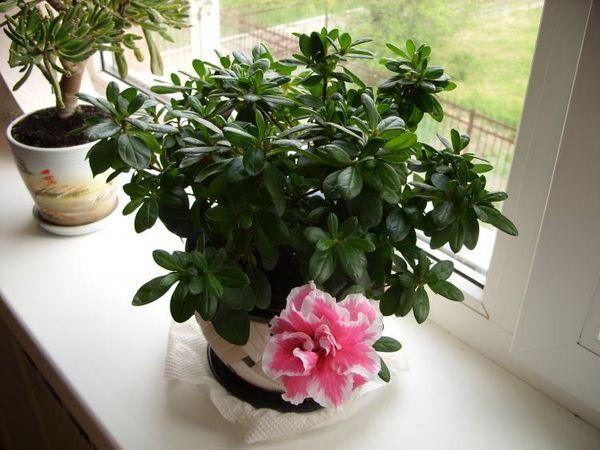
Watering
During the flowering period, the azalea is watered daily. A little soft water is poured into the pot and make sure that the earth is well moistened. Once a week, the indoor azalea can be placed in a large bucket filled with warm water for a couple of hours. The plant will bloom the next year, if the soil is regularly watered after flowering.
The soil in the pot should not dry out under any circumstances. The watering fluid must be free of chlorine and lime. It is advisable to use rainwater. You can add a little complex fertilizer, citric acid (2 grams per liter) or a tea bag to the liquid.
Top dressing
The soil mixtures on which azaleas grow are poor in nutrients. In winter, the plants are not fed. In the spring, when the branches begin to grow, complex and nitrogen-containing supplements are added once a week.
Fertilizers should not contain chlorine-containing salts. In summer, when flower buds are laid, azaleas need more phosphorus and potassium. It is better not to feed the plant with nitrogen substances at this time.
For top dressing, purchased fertilizers for azaleas or ammonium nitrate, superphosphate, potassium sulfite are used. 2 grams of fertilizer are taken per liter of water.
Mulching
The soil in the pot will not dry out if you pour a little mulch on top. The surface is mulched with needles or peat mixed with sawdust.
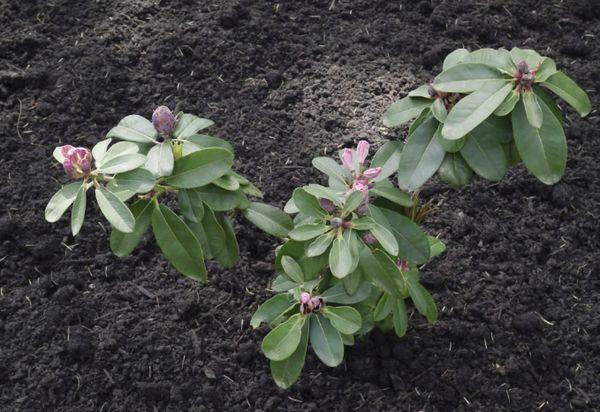
Spraying
Azalea suffers greatly from drought. In summer, it can be sprayed several times a day. Leaves are irrigated with chilled water on both sides. In winter, the azalea can be sprayed once a day.
Pruning
Azalea branches must be pruned. This procedure stimulates the appearance of young branches, on which new buds appear. Pruning is done in the spring, after flowering. You need to cut off the elongated shoots. It is important to thin out the bush. It is imperative to remove weak and diseased branches. Azalea will bloom profusely if the bush is not too lush.
Transfer
The growing azalea is carefully transplanted into a large container once a year. An adult plant is placed in another pot every 3-4 years.
Time and reasons
Azalea is transplanted immediately after flowering (closer to summer). The earth is replaced with a new, more nutritious one. The plant is transplanted into a larger pot so that the roots can develop freely, do not get tangled, and breathe well.

Pot selection
The new pot should be 5 centimeters larger than the old one. The previous container should freely enter the new one. The pot should have a drainage hole at the bottom.
Soil composition
For transplanting azaleas, it is advisable to buy a ready-made soil mixture. You can not use garden soil, as it may not be suitable in composition and be infected with various infections. Azaleas love slightly acidic soil. The earth should be light, loose, permeable.
Ingredients of soil mixture for azalea:
- coniferous land;
- peat;
- sand;
- leaf humus;
- pine bark;
- heather land.
All components are taken in the same proportions. Grind the ingredients well.It is convenient to use expanded clay as a drainage for azalea. The soil is fertilized with minerals and biohumus.
How to transplant
Azalea is transplanted very carefully and carefully, trying not to damage the thin and barely noticeable roots. The transshipment method is used. The plant, along with an earthen lump, is carefully transferred from one pot to another. During transplantation, the root collar must not be buried.
Features of the transplant after purchase
At the bottom of the transplant pot, some small stones are poured for drainage. Then earth is poured on top. Before transplanting, the azalea is watered. After an hour, the pot is turned over, the plant is carefully removed from the container, together with an earthen lump. The azalea is dipped into a new pot and sprinkled with a moistened substrate up to the root collar. After transplanting, water it.
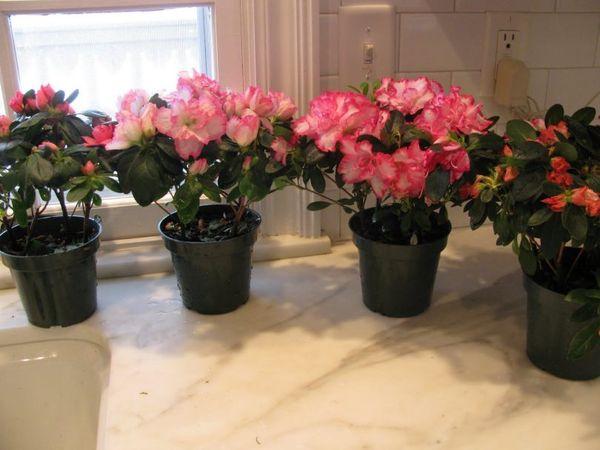
Housekeeping problems
In case of improper care or due to a lack of nutrients in the soil, azalea leaves can shrivel, darken, turn yellow, fall off. It is important to correctly identify the cause of the problem and correct it immediately.
Darkened leaves
If the azalea has darkened and the leaves began to fall off, it means that it is being watered incorrectly. The plant sheds foliage if the room is too hot and dry. It is necessary to reduce the temperature, increase the soil moisture. The soil in the pot should not dry out.
Looks lifeless
If the azalea leaves turn yellow, and the plant itself looks lifeless, then it does not have enough nutrients. The land must be fertilized with nitrogen, phosphorus, potassium. You can use complex fertilizers. Azalea can turn yellow due to excess lime. It is advisable to water the earth with soft, acidified water.
Transportation in winter
If in a cold season the plant needs to be transported from one place to another, it is advisable to insulate it well. The flower must not freeze, otherwise it will die.
Leaves wrinkled
If the azalea has wrinkled leaves, it means that it is hot and does not have enough water. The plant needs to be watered abundantly, water the leaves. Can be immersed in a bucket of water. It is desirable to lower the air temperature (up to 15 degrees).
Diseases and pests: control measures
Indoor azalea can get sick or attacked by insects. Proper care, preventive treatment with fungicides and insecticidal solutions helps to save the plant.
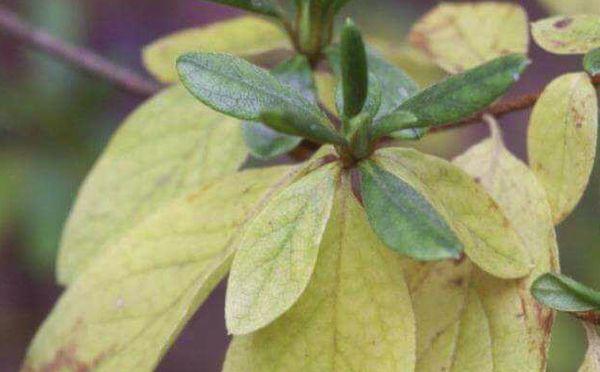
Chlorosis
Azalea leaves turn yellow if watered with too hard water. The watering liquid should be soft, slightly acidic. You can feed the plant with iron chelate. The chlorosis may be caused by an improperly selected soil mixture. In this case, the substrate must be changed.
Late blight
The infection first infects the roots of the azalea and then spreads to other parts of the plant. Dark spots appear on the leaves. For treatment, the fungicide Fitosporin is used.
Necrosis
The leaves may turn yellow and dry out if the azaleas are too hot or, conversely, the plant is frozen. You should create optimal living conditions and water the flower abundantly.
Strawberry mite
A tiny insect that lives in highly moist soil. It feeds on leaves and buds. Spots appear on the leaves, later they curl, wither and fall off. Treatment with Fitoverm or Neoron will save you from ticks.
Spider mite
A small red insect, braiding leaves and stems with a thin cobweb. It feeds on plant sap. May lead to yellowing and wilting of leaves. Actellik's solution saves from the tick.
Mole
A gray butterfly laying eggs from which caterpillars emerge. They feed on leaves. The insecticide Aktara saves from caterpillars.
Mealybug
A tiny light shaggy insect that looks like a louse. It feeds on plant sap, which is why azaleas do not grow well. Spraying with insecticides (Aktara, Konfidant, Fitoverm) saves him.
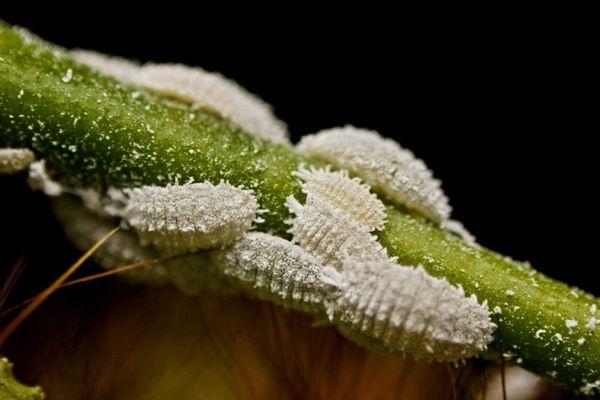
Rhododendron bug
A tiny dark insect with shiny transparent wings. It feeds on plant sap, leads to yellowing and drying of leaves. Kinmiks, Karbofos, Decis saves from the bug.
Reproduction
Azalea can be propagated in a variety of ways. For example, by seeds, cuttings, dividing a bush, grafting. The easiest way is to buy a ready-made plant right away.
How to root cuttings
Young, not yet fully lignified twigs (8 centimeters long) cut at an angle of 45 degrees should be placed in water. Remove the lower leaves. It is advisable to cut the cuttings in the spring. A growth stimulator (Kornevin) must be added to the water.
When roots appear on the handle, it must be planted in a special soil mixture. Cuttings are planted vertically, to a depth of 2 centimeters. Cover the top with a plastic bottle and a dark cloth. Water regularly, keep at a temperature of 25 degrees. After 2 months, the plant takes root, the bottle is removed, and after 1.5-2 years a young azalea grows.
Graft
An azalea stalk can be grafted into an adult plant in the spring. The graft is cut at an angle of 45 degrees and fastened to the stock. The stalk will take root after 2 weeks if the plant is constantly watered and watered.
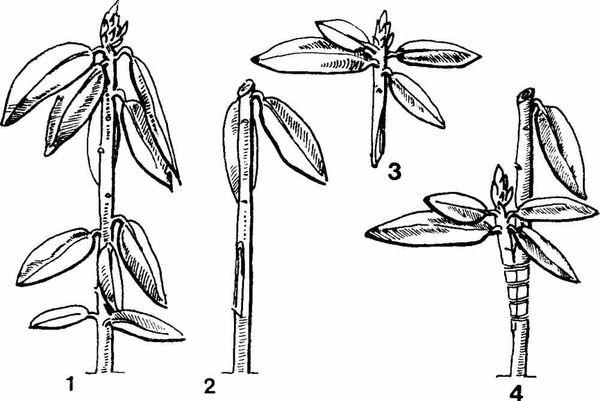
Germinating seeds
Before planting, the seeds are soaked and germinated a little in water. Then they are sown together with sand on fertilized soil and irrigated regularly. Cover the top of the pot with foil. When the seedlings grow up, they are dived and transplanted into separate boxes.
Dividing the bush
In the spring, after the azalea has faded, the bush is removed from the pot and divided into several parts with a knife. Each part should contain 1-2 shoots. All segments are seated in separate pots and placed in a dark place for a week.
Virulence
Rhododendrons are very cunning. These beautiful plants are dangerous. Flower nectar and pollen can be deadly poisonous not only to animals, but also to humans. There is a Greek legend according to which soldiers during a military campaign were poisoned with honey collected by bees from Pontic or Yellow rhododendrons. The poisoning was narcotic. The honey from these plants can have a laxative or hallucinogenic effect.
Azaleas are toxic to animals. They can die by eating a few leaves. The danger to humans is the andromedotoxin glycoside, which is contained in rhododendrons. This substance acts on the central nervous system: first exciting, and after a while - depressing. May cause human death. The poisonous substance is present in leaves, stems, flowers, nectar, and collected honey.
How to form a bonsai
Azaleas are used to form bonsai for several years. With the help of 5-6 pruning, they make the plant turn into a small tree with a thick trunk and a lush top. In the first years, the trunk is formed from the central stem. The side branches are removed. When the tree reaches the desired height, pinch the top. At the end, a crown is formed.
Reviews
Anna Denisovna:
“They gave me an azalea for my birthday. I soon noticed that the plant was starting to wilt. I placed the pot of azalea in a large vase and poured it halfway down the cold water. Azalea came to life, water from the outer pot constantly evaporated, cooled the roots and created the necessary microclimate for the plant.

